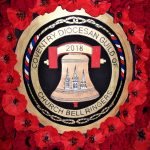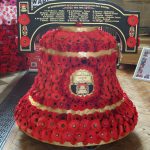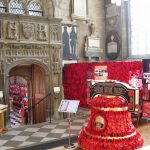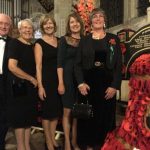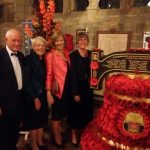In Autumn 2017, posters appeared in Warwick proclaiming ‘WE NEED YOUR POPPIES’. St. Mary’s Church was planning a huge display to commemorate the centenary of the end of WW1, hoping to get 11,610 poppies; the number of Warwickshire soldiers killed. The display would flow out from the regimental chapel and around the church from October 2018 until the end of the Christmas tree festival in December 2018, the idea being that it would be a community effort and that anybody could knit, crochet, or make poppies out of anything they chose. Poppy drop stations were set up in the church and various local shops to hand in poppies.
I decided to make a few paper ones myself and had made about 60 by November. Shortly after, at a craft session in St. Mary’s, we were talking about the project and I suggested that the bellringers could perhaps do something towards the display. “We could make a bell the size of the tenor, cover it in poppies, and put the names of the Guild ringers killed in WW1 on the headstock”.
What started off as a suggestion quickly received approval in principle from the Poppy Team and so the next challenge was to get the rest of the ringers at Warwick on board with another of my crazy ideas. No worries there: the response was in favour of going ahead with the project.
Then the headaches began. All I had was a photo of the 25cwt tenor and I knew that it’s diameter was about 54inches. My Dad suggested it would be best to draw up some small scale plans for a 12inch diameter model in order to work out the best way of constructing the full size one in cardboard. I took about a month to work out the templates for this and to make the miniature using cereal boxes. The full size bell would be built in three sections, for ease of construction and transport. Originally I wanted to make it in the huge ringing room at St. Mary’s. However, a tight spot on the spiral staircase precluded this idea, even with the bell in sections. Fortunately, we had an offer from the nearby St. Nicholas’ church, where we also ring, to build it on the balcony there. This was gratefully accepted and we would sort transportation up the road to St. Mary’s nearer the time.
After scaling up the templates to full size the next step was to collect and cut sufficient cardboard for the 120 sections and 8 circles that were required. At the same time, many ringers and their families were busy knitting or crocheting poppies and, along with my paper ones, it was beginning to look like we were going to have enough to cover this huge bell. All the card sections were now cut and we assembled it at St. Nicholas’ church on 13th March. I wanted to get as many of the Warwick band involved as possible so I went once or twice a week with somebody to have a session on the project, firstly to apply papier-mache to the card skeleton, then paint it black and add gold ribbons around where the section joins would be. This was about 35 hours work and took us up until the end of April.
Back at home, I worked on the designs for each side of the bell. Taking inspiration from a new members’ certificate from the early 1900s, the 1918 panel has the Warwickshire Guild of Church Bell Ringers on it and the 2018 side incorporates our present logo, the Guild having changed it’s name after the creation of the Coventry Diocese.
The headstock was under construction and I had help with cutting the inner polystyrene core. This was then covered in card. The wording that would best fit onto the headstock was then worked out. The 1918 side would have the names of the 18 Guild ringers killed in WW1 and the towers where they rang. The Guild had approx. 220 members at that time and the county boundary was also different. The 2018 side includes, ‘We peal in muffled sadness for loved ones laid to rest’ from the bellringers’ hymn and details about the actual tenor at St. Mary’s. Designing the layouts on greaseproof paper, transferring and hand-painting them onto lining paper and building the headstock took me about three months.
Towards the end of April I gathered in the knitted poppies, hoping I would have enough for four rings around the bell. I needn’t have worried, the knitters and crocheters had done me proud: there were plenty, enough as well to go around each of the side panels. As everyone’s poppies were different in style, colour and size I then worked out where best to deploy them on the bell. We pinned them on to get the layout correct then sewed each one on using a half circle needle and knotted all 276 into place. This took us until the end of May.
By the beginning of June I had made 305 paper poppies of varying sizes, hand painted, and with buttons in the centre, gleaned from various old button tins. I had help cutting and painting about 60 of them. We started on the mammoth jigsaw puzzle of sewing them on to the bell. I’d worked out we needed to sew on about 35 poppies each session to finish on time. Four large poppies on the crown of the bell represent the four Royal Warwickshire Regiment soldiers out of the 18 names listed on the headstock.
The poppy team asked if we would like to send to them some words and a photo by the end of June to be included in the glossy commemorative booklet that will go with the main display. I decided to finish the 1918 side of the bell first and temporarily put the headstock on, showing the side with the ringers’ names, get a decent photo and to compose a short piece of writing to send to the Poppy Team. By 22nd June, after quite a few sewing sessions, the 1918 side was finished and I took the completed headstock along to St. Nicholas’ and slotted it on the top of bell for the first time. That was a moment I won’t forget: seeing it all together and what it will finally look like. We had a trial run of moving the whole bell that morning as well and took the sections down into the nave of the church, assembled it and took some photos. We then moved it back up on to the balcony ready to work on the 2018 side over the next few weeks. We had a visit from the Poppy Team co-ordinators at St. Mary’s to see our project in the flesh, it does look rather different in real life than in the photo updates I had been sending to them.
The plan was to finish by the end of July in case we needed extra time for contingencies, eg. if more poppies were needed. Whilst sewing the small paper poppies onto the top section of the bell it became apparent that there weren’t enough and so I made another 30. There are a total of 610 poppies on the bell including one British Legion poppy hidden amongst the others. Finally the headstock was fixed into place and the ribbons cut ready to cover the section joins once in situ at St. Mary’s. The Poppy Team asked if we could keep our bell covered once it was moved up to St. Mary’s as they wanted a few of the special displays to be kept a surprise until the official launch on 5th October. Accordingly, I made a suitable cover for it which will also keep it dust free until it is displayed .Then apart from a few tweaks and a touch up of paint we were ready. I went and covered it up on 31st July, right on schedule, and could now have a break until the end of September when the bell would be moved up to St. Mary’s.
Hiring a van to move the bell seemed the sensible option after measuring numerous ringers cars and finding that the base section was just too big to fit through the doors even if there would have been room inside. So on a sunny morning on 27th September we loaded the bell into the van and drove the short way up the hill to St. Mary’s church. The bell was assembled in the south transept and the ribbons to cover the section joins were fixed into place, drawing a small crowd of visitors and poppy team helpers with plenty of questions in the process. I had wondered if the bell would look small in the huge space of St. Mary’s but I needn’t have worried, it is just right.
By the 5th October St. Mary’s church was looking fabulous and after uncovering the bell in the morning, a few of us attended and had an enjoyable time at the gala dinner that evening for the official launch of the main display and our remembrance bell was now finally on show.
Over the 20 weeks we were working on it construction time had consumed about 55 hours and poppy sewing had taken an additional 55 hours. This doesn’t count the hundreds of hours that must have been spent by the many people making the poppies, design work, cutting card etc. I was helped by 22 Warwick ringers and family members: supplying materials, cutting card, helping with construction, papier-mache, painting and fixing the ribbons, knitting and crocheting, giving advice on the wording for the headstock and our articles for the brochure and newsletters. Some helped sew on the poppies that they had knitted, others just turned up and did what was needed on the day, mainly poppy sewing, several coming back for more than one session. There were a few scary moments especially at the beginning when working out the best way to tackle things on this huge structure but once we got to grips with it, sessions went without a hitch, although you could almost guarantee that each time we would have to resew a few wayward poppies.
I couldn’t have completed the project without all our ringers’ help and support. Thanks to everyone that took part and thanks to St. Nicholas Church for letting us use their space to construct and work on our project.
The Poppy Team at St. Mary’s have been amazed at the number of poppies that have been produced by the general public over the last year from all corners of the world and announced at the gala dinner that there is the astounding total of 62438 poppies in the main display, with still more being handed in. This magnificent tribute will be open in St. Mary’s Church, Warwick from 6th October until 9th December 2018 and we hope you can find time to come and see not only our Remembrance bell but the whole display.
Karen French.
Warwick Bellringer.
Send to a friend


